|
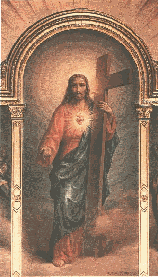
|
This chapel is on the left, near the main entrance. It is small,
pleasing and quiet, and very suitable for anyone who wants to
pray. Many ordinary folk and pilgrims visit it.
Why the Sacred Heart?
Don Bosco's own great devotion.
He himself wrote that, after the revelations to St Margaret Mary
Alacoque, "This
devotion was taken up by clergy and lay people with exceptional
zeal, as though it corresponded to some pressing need of the
human heart".
Fr G.Barberis SDB wrote about Don Bosco's devotion:
|
"Don Bosco's
devotion to the Sacred Heart was admirable. He recommended it
in a big way to his boys…". |
|
He showed his love and
devotion by undertaking, near the end of his life, and at great
cost and sacrifice to himself, the construction of the Basilica
of the Sacred Heart, next to Rome's Termini Station.
|
DREAM OF THE TWO PILLARS... |
At
the back of the Basilica can be seen the two paintings of the Dream
of the Two Pillars and the Dream of the Raft. 30 May 1862, Don Bosco told how, in a dream,
he had seen a terrible sea-battle with thousands of crafts, big
and small, launched against a single stately ship symbolising
the Church.
The ship had been hit several times, but
was still proudly afloat. Directed by the Pope it was able to
anchor itself securely between two pillars rising out of the
sea. On top of the first pillar was a large Host and the words
"Salus credentium"
(Salvation of believers). The
second pillar was smaller and there was a statue of Mary Immaculate
on it with the words "Auxilium
Christianorum" (Help of Christians).
Don Bosco told the dream of the
Raft in 1866. Caught by a frightful
flood, the boys try to save themselves by getting on a raft with
Don Bosco and they see the mysterious word MEDOUM in the sky.
The Saint explained it as "Mary, Mother and Lady
of the whole universe". When the raft was tied up in a safe
place, the Virgin Mary spoke to the boys:
|
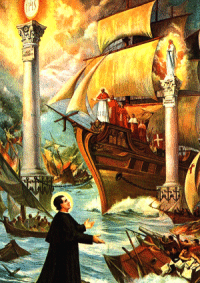 |
"IF YOU WILL
BE LOVING CHILDREN TO ME,
I WILL BE A LOVING MOTHER TO YOU". |
|
CHAPEL OF THE RELICS (THE CRYPT) |
When you enter
the Basilica by the main door, on the right-hand side you will
find a stairway leading to the Crypt or "Chapel of the Relics".
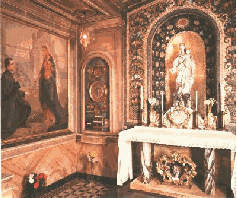
|
It has one nave
and is shaped like a Latin cross. The ornamental motifs and symbols
recall the Christian catacombs. Numerous relics of martyrs
and saints are preserved in the chapel. Its centrepiece is the relic of the
Wood of the Cross, conserved in a container with an alabaster
background.
Important in its own way is the little
chapel dedicated
to Our Lady,
and commonly called the
"Chapel
of the Apparition" on
account of the 1845 dream related by Don Bosco: |
I
seemed to be in a vast meadow with a huge crowd of boys. I saw
a Lady beside me. She told me: "In this place, where the
glorious martyrs of Turin, Adventor and Octavius, suffered martyrdom,
on those clods soaked and sanctified by their blood, I wish that
God be honoured in a very special manner. So saying, she put our her foot and
pointed to the exact spot where the martyrs had fallen".
|
The spot is indicated, on the floor, by a golden cross.
Two altars contain
the mortal remains of
Blessed Michael
Rua,
Don Bosco's first successor, and of
Blessed Philip
Rinaldi,
Don Bosco's third successor.
|
BLESSED
MICHAEL RUA (1837-1910) |
Michael Rua was born very near
Turin-Valdocco. He was eight
years old when he met Don Bosco
and asked him for a holy picture. The saint made a sign that
looked like he was cutting something in half. As he did so, he
told the child: "Take it,
Michael, take it: the two of us will always go halves." He was right in his prediction: Don Rua would
be his most faithful collaborator and his first successor in
guiding the Salesians.
He was a tireless worker and the genial organiser in the young
Salesian Society. Don Bosco said of him:
"If I had ten Don Ruas I
would conquer the world". He also said: "DON
RUA, IF HE WANTED, COULD PERFORM MIRACLES. If I wanted to single
out any point where he was not absolutely perfect in virtue,
I would be stuck, because I could not find any."
|
He was a great worker and a great saint, exactly
like Don Bosco.
He was declared Blessed by Paul VI on 29 October 1972.
|
BLESSED PHILIP
RINALDI (1856-1931) |
He was Don Bosco's third successor in guiding the Salesian
Society. Like Don Rua, Philip knew Don Bosco from childhood.
But he only surrendered himself to him
when he was 21 years old. Don Rinaldi is considered
the real founder of Salesian work in Spain and Portugal.
He was the genial (for those days)
founder of the flourishing VDB Secular Institute, the Women Volunteers
of Don Bosco.
A deeply prayerful man, with a rich inner life and a son's
devotion to Mary Help of Christians, he was declared Blessed
by John Paul II on 29 April 1990.
He
wrote this spiritual note to his VDB Daughters: |
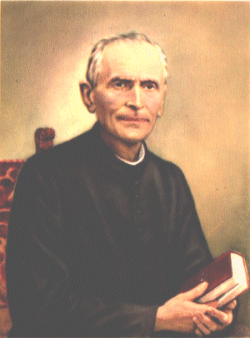
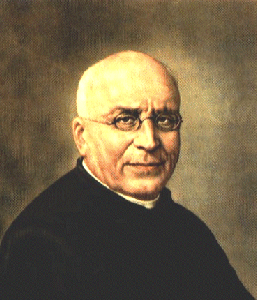
|
„ What must you do to have life? Before all else, the
first thing you have to do is pray for courage every day to carry
the cross the Lord has assigned you. Then let each of you do
your own work really well, the work proper to your state, as
God wants it, and according to your condition, which means according
to the spirit of the Lord and of Don Bosco".
|
The Crypt also contains
objects that belonged to the first Salesian martyrs Mgr Luigi
Versiglia and Fr Callisto Caravario, both of whom were pupils
in the Mother House at Turin-Valdocco.
The First Salesian Martyrs
Mons. A. VERSIGLIA & Fr C. CARAVARIO |
Aloysius Versiglia
was born at Oliva Gessi (Pavia) in 1873. At the age of 12 he
went to study at Turin-Valdocco - on condition he didn't become
a priest! But God's grace, the thoroughly religious atmosphere,
the enthusiasm for the missions and of course the charm and sanctity
of Don Bosco, by now in his last years, transformed the boy's
soul. One day he heard the Saint of Youth say, "Come and see me; I've something to say to you".
The meeting never took place owing to Don Bosco's death, but
he'd been won over all the same and so after his studies he asked
simply 'to stay with Don Bosco', fostering in his heart the secret
hope of one day setting out as a missionary. He studied philosophy
and theology in Rome, but all the while 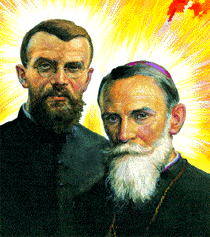 he
gave an important pastoral service in the Sacred Heart Oratory
near the city's main railway station Stazione Termini. He became
a teacher and novices' assistant at Foglizzo near Turin. He was
always an effective 'shaper' of personalities, loving and a good
friend to all. At the age of thirty three he went to China as
leader of a small group of Salesians. In 1920 he was consecrated
bishop and appointed Vicar Apostolic of Schiu Chow.
he
gave an important pastoral service in the Sacred Heart Oratory
near the city's main railway station Stazione Termini. He became
a teacher and novices' assistant at Foglizzo near Turin. He was
always an effective 'shaper' of personalities, loving and a good
friend to all. At the age of thirty three he went to China as
leader of a small group of Salesians. In 1920 he was consecrated
bishop and appointed Vicar Apostolic of Schiu Chow.
In 1929 Bishop Versiglia ordained Callistus Caravario as a Salesian priest
at Schiu Chow. He had been born at Cuorgnè near Turin
and he, too, had studied at Turin-Valdocco. There in 1922 he
had met the bishop and promised him, "I'll follow you to China". And
so he did.... On 23rd February 1930 they set out together on
a long apostolic journey. But two days later they met their deaths
together at the hands of communist bandits. They were killed
because they were Catholic missionaries who were preaching the
Gospel of Jesus Christ and also because they had protected some
young female catechists travelling with them, whom the bandits
wanted to carry into slavery. These
two Salesian martyrs died not only for their faith in Christ,
but also for defending human dignity.
Pope John Paul II declared them saints in Rome on 1st
October 2000, the Jubilee Year. Their Feast is celebrated on
13th November.
|
THE SACRISTY OF
THE BASILICA |
Like every great
church the Basilica of Mary Help of Christians has a spacious
sacristy. It runs alongside the gallery which is behind the high
altar. Not only is it big and well lit, but it is also very functional,
especially on big occasions when there are many concelebrants.
It provides two access points to the church, which facilitate
religious services.
As well as the
great vesting table, where the sacred vestments are kept, there
is a line of choir stalls against the wall facing the sanctuary.
They are elegant in their simplicity and usefulness and provide
priests with the opportunity of quietly preparing for their celebration
of mass. Sometimes they are also used as confessionals by the
faithful who come into the sacristy for information or counselling.
The floor is made of marble. There's also a simple, but artistic,
wash hand basin, of special marble.
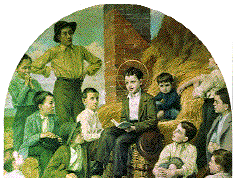 The
sacristy is enriched by six interesting paintings by the artist
Crida, which depict certain moments in Don Bosco's life and give
the pleasant feeling of still seeing the saint wandering about
his beloved Basilica of Mary Help of Christians. Let us give
you a brief description and explanation of them.
The
sacristy is enriched by six interesting paintings by the artist
Crida, which depict certain moments in Don Bosco's life and give
the pleasant feeling of still seeing the saint wandering about
his beloved Basilica of Mary Help of Christians. Let us give
you a brief description and explanation of them.
In the first painting the artist goes back
to little Johnnie Bosco as a youthful catechist amidst the poverty
of his birthplace. He is sitting on a basket and is surrounded
by a 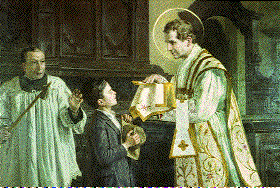 group
of companions, who after being led by him in their games are
now listening to his words very attentively. Don Bosco said later
that the Salesian Congregation was founded on catechesis.
group
of companions, who after being led by him in their games are
now listening to his words very attentively. Don Bosco said later
that the Salesian Congregation was founded on catechesis.
The
second painting
shows the scene of the meeting between Don Bosco and the orphan
Bartholomew Garelli in the sacristy of St. Francis of Assisi
church in Turin. This historic meeting took place on the 8th
December 1841 and it marked the beginning of his apostolate for
the young, first in Turin and then throughout all the Salesian
Family in the world.
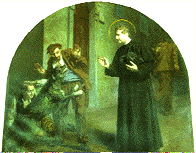 In the third
painting
we find the
mysterious dog 'Grigio' depicted. (In English 'grigio' means
'grey'.) He 'appeared' several times when Don Bosco's life was
threatened by the enemies
In the third
painting
we find the
mysterious dog 'Grigio' depicted. (In English 'grigio' means
'grey'.) He 'appeared' several times when Don Bosco's life was
threatened by the enemies 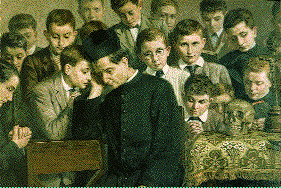 of
his work and the mysterious 'Grigio' would get him out of danger.
We have no doubt about the existence of 'Grigio', because he
was seen by very many witnesses, among whom was Mamma Margaret;
but it is still debatable who or what this dog represented.
of
his work and the mysterious 'Grigio' would get him out of danger.
We have no doubt about the existence of 'Grigio', because he
was seen by very many witnesses, among whom was Mamma Margaret;
but it is still debatable who or what this dog represented.
In
the fourth picture
we see Don Bosco hearing his boys' confessions. He gave great
importance to the Sacrament of Reconciliation. He used to consider
it one of the pillars of the Christian formation he gave to the
boys (along with Holy Communion and devotion to Mary Help of
Christians). The boy making his confession is Paul Albera, who
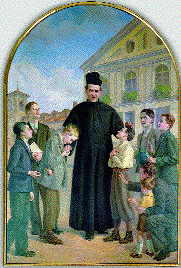 later
became, after Fr. Michael Rua, Don Bosco's second successor in
leading the Salesians.
later
became, after Fr. Michael Rua, Don Bosco's second successor in
leading the Salesians.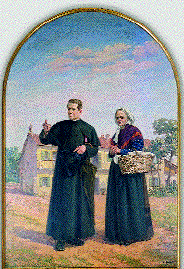
The
fifth picture
shows
Don Bosco in the middle of his boys, who hold him in great affection
and listen to his every word. In the background of the painting
is the first building he ever built in Valdocco. On 31st January
1988, the first centenary of his death, Pope John Paul II declared
Don Bosco to be the
'Father and Teacher of Youth'.
The
last painting shows
Don Bosco returning to Turin with Mamma Margaret on 3rd November
1846. For ten years she helped Don Bosco in very practical ways
in his ministry to young people, keeping him company, advising
him and encouraging him. She acted as mother also to the first
boys gathered in the poverty-stricken Pinardi House. Many of
these were orphans, too. Her cause for beatification and canonisation
has been introduced.


| HOME PAGE | BASILICA
| SAN GIOVANNI BOSCO | CAPPELLA
PINARDI | S. FRANCESCO DI SALES
| CAMERETTE | A.D.M.A.
| RIVISTA M. A. | C.
S. D. M. | INFO VALDOCCO
|
VISIT Nr. 





 he
gave an important pastoral service in the Sacred Heart Oratory
near the city's main railway station Stazione Termini. He became
a teacher and novices' assistant at Foglizzo near Turin. He was
always an effective 'shaper' of personalities, loving and a good
friend to all. At the age of thirty three he went to China as
leader of a small group of Salesians. In 1920 he was consecrated
bishop and appointed Vicar Apostolic of Schiu Chow.
he
gave an important pastoral service in the Sacred Heart Oratory
near the city's main railway station Stazione Termini. He became
a teacher and novices' assistant at Foglizzo near Turin. He was
always an effective 'shaper' of personalities, loving and a good
friend to all. At the age of thirty three he went to China as
leader of a small group of Salesians. In 1920 he was consecrated
bishop and appointed Vicar Apostolic of Schiu Chow. The
sacristy is enriched by six interesting paintings by the artist
Crida, which depict certain moments in Don Bosco's life and give
the pleasant feeling of still seeing the saint wandering about
his beloved Basilica of Mary Help of Christians. Let us give
you a brief description and explanation of them.
The
sacristy is enriched by six interesting paintings by the artist
Crida, which depict certain moments in Don Bosco's life and give
the pleasant feeling of still seeing the saint wandering about
his beloved Basilica of Mary Help of Christians. Let us give
you a brief description and explanation of them. group
of companions, who after being led by him in their games are
now listening to his words very attentively. Don Bosco said later
that the Salesian Congregation was founded on catechesis.
group
of companions, who after being led by him in their games are
now listening to his words very attentively. Don Bosco said later
that the Salesian Congregation was founded on catechesis. In the third
painting
we find the
mysterious dog 'Grigio' depicted. (In English 'grigio' means
'grey'.) He 'appeared' several times when Don Bosco's life was
threatened by the enemies
In the third
painting
we find the
mysterious dog 'Grigio' depicted. (In English 'grigio' means
'grey'.) He 'appeared' several times when Don Bosco's life was
threatened by the enemies  of
his work and the mysterious 'Grigio' would get him out of danger.
We have no doubt about the existence of 'Grigio', because he
was seen by very many witnesses, among whom was Mamma Margaret;
but it is still debatable who or what this dog represented.
of
his work and the mysterious 'Grigio' would get him out of danger.
We have no doubt about the existence of 'Grigio', because he
was seen by very many witnesses, among whom was Mamma Margaret;
but it is still debatable who or what this dog represented. later
became, after Fr. Michael Rua, Don Bosco's second successor in
leading the Salesians.
later
became, after Fr. Michael Rua, Don Bosco's second successor in
leading the Salesians.